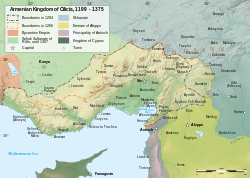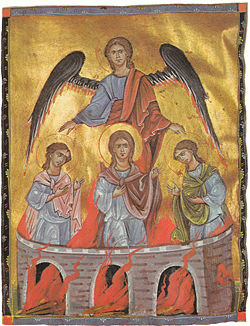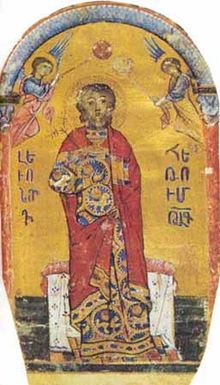Toros Roslin
Toros Roslin | |
|---|---|
| Թորոս Ռոսլին | |
 Statue of Toros Roslin in front of the entrance of theMatenadaran | |
| Born | 1210 |
| Died | 1270 (aged 60) |
| Nationality | Armenian |
| Known for | Illuminated manuscripts |
| Patron(s) | CatholicosConstantine I Hethum I |
Toros Roslin(Armenian:Թորոս Ռոսլին,Armenian pronunciation:[tʰɔɹɔsrɔslin]);c. 1210–1270)[1]was the most prominentArmenian manuscript illuminatorin theHigh Middle Ages.[2]Roslin introduced a wider range of narrative in his iconography based on his knowledge ofwestern Europeanart while continuing the conventions established by his predecessors.[2]Roslin enriched Armenian manuscript painting by introducing new artistic themes such as theIncredulity of ThomasandPassage of the Red Sea.[3]In addition he revived the genre of royal portraits, the first Cilician royal portraits having been found in his manuscripts.[4]His style is characterized by a delicacy of color,classical treatmentof figures and their garments, an elegance of line, and an innovative iconography.[5]
The human figures in his illustrations are rendered full of life, representing different emotional states. Roslin's illustrations often occupy the entire surface of the manuscript page and at times only parts of it, in other cases they are incorporated in the texts in harmony with the ensemble of the decoration.[6]
Biography
[edit]
Little is known about Toros Roslin's life. He worked at the scriptorium ofHromklain theArmenian Kingdom of Ciliciawhere thepatriarchal seewas transferred to in 1151.[2]His patrons includedCatholicosConstantine I,kingHethum I,his wifeIsabella,their children and princeLevon,in particular.[7]Thecolophonsin Roslin's manuscripts permit scholars to partially reconstruct the world in which he lived in.[8] In these colophons Roslin appears as a chronicler, who preserved facts and events of his time. In his earliest surviving manuscript theZeytun Gospel of 1256,Roslin signed his name as "Toros surnamed Roslin".[9]
Only Armenians of noble origin had a surname in the Middle Ages; however, the surname of Roslin does not figure among thenoble Armenian families.[10]Roslin may have been an offspring of one of the marriages common between Armenians and Franks (any person originating in Catholic western Europe) that were frequent among the nobility but occurred among the lower classes as well.[7]Roslin also names his brother Anton and asks the readers to recall the names of his teachers in their prayers.[7]

Levon Chookaszianproposed a more detailed explanation of the appearance of this surname in the Armenian milieu. He asserted that the surname Roslin originated from Henry Sinclair of theClan Sinclair,baron ofRoslinwho accompaniedGodfrey of Bouillonin the 1096CrusadetoJerusalem.Chookaszian's hypothesis is based on the assumption that like most prominent Crusaders of the time,[11]Sinclair married an Armenian.[8]
The approximate dates of Roslin's birth and death can be determined using the dates of his manuscripts. Based on the following it can be assumed that Roslin was at least 30 in 1260.[9]At the time one could only achieve the level of mastery displayed in theZeytun Gospel of 1256no earlier than in their mid twenties. In the colophon of theGospel of 1260,Roslin mentions that he has a son, indicating that he was likely a priest since a monk would have no children while a member of the laity would likely not have been an illuminated manuscript painter. By the time of theGospel of 1265,Roslin already had his own apprentices. Roslin painted two portraits of prince Levon, the earliest of which was executed in 1250[12](the prince was born in 1236) and the second in 1262 showing the prince with his brideKeran of Lampron.Roslin's name isn't seen on any manuscript dated after 1286 and he most likely died in the 1270s.[13]None of Roslin's contemporaries or his pupils refer to him in their work and in the following centuries, his name is only mentioned once when the scribe Mikayel working inSebasteain the late 17th century found in his monastery a gospel book illustrated in 1262 by the "famous scribe Roslin" which he later copied.[14]
Manuscripts
[edit]
Signed by Toros Roslin
[edit]Seven manuscripts have been preserved that bear the signature of Roslin, they are made between 1256 and 1268 five of which are copied and illustrated by Roslin.[15]Of these four are owned by theArmenian Patriarchate of Jerusalemlocated in theCathedral of St. James.These include theGospel of 1260(MS No. 251) copied for Catholicos Constantine I.[16]TheGospel of 1262(MS No. 2660) was commissioned by Prince Levon, during the reign of King Het’um (I, 1226 to 1270),[17]copied atSisby the scribe Avetis, illustrated by Roslin at Hromkla and bound by Arakel Hnazandents.[18]TheGospel of 1265(MS No. 1965) was copied for the daughter of Constantine of Lampron, lady Keran who after the death of her husband Geoffrey, lord of Servandakar, retired from the world.[19]Mashtots(MS No. 2027) was commissioned in 1266 by bishop Vartan of Hromkla, copied by Avetis who had previously collaborated with Roslin in 1262 at Sis and illustrated by Roslin at Hromkla.[19]
TheSebastia Gospel of 1262(MS No. 539) is located inBaltimore'sWalters Art Museum.It was copied for the priest Toros, nephew of Catholicos Constantine I. Written inuncialsit is the most lavishly decorated among the signed works of Roslin.[16]The manuscript was kept inSivassince the 17th century where it remained until the deportation of Armenians in 1919. Ten years later it was purchased by American rail magnateHenry Waltersin Paris, whose long standing interest in Armenian art was rekindled by the tragic events of the previous decade. His wife Sadie Walters donated the manuscript to the Walters Art Museum in 1935.[20]TheZeytun Gospelsof 1256 (MS. 10450), copied for Catholicos Constantine I {See link[21]}and theMalatia Gospel of 1268(MS No. 10675) are located at theMashtots Institute of Ancient ManuscriptsinYerevan.The manuscript (formerly MS No. 3627) was presented to CatholicosVazgen Ias a gift by Archbishop Yeghishe Derderian, patriarch of Jerusalem. The Catholicos in turn gave the manuscript to the institute. The manuscript was commissioned by Catholicos Constantine I as a present for the young prince and future kingHethum.[22]In the colophons of the manuscript Roslin describes the brutal sack of thePrincipality of Antiochby theMamlukSultanBaibars:"...at this time great Antioch was captured by the wicked king of Egypt, and many were killed and became his prisoners, and a cause of anguish to the holy and famous temples, houses of God, which are in it; the wonderful elegance of the beauty of those which were destroyed by fire is beyond the power of words."[23]
Canon tables and ornaments
[edit]The principal innovation of Roslin in regards to ornaments withincanon tablesis the addition of bust portraits.[24]In the Gospel of 1262 (MS No. 2660),Eusebiusand Carpianus are represented as full figures standing in the outer margins of the Letter of Eusebius. Roslin also represented prophets such asDavid,MosesandJohn the Baptist.[25]This system was highly unusual for canon table decoration, for although portraits of prophets had been represented next to canon tables as early as the 6th-centurySyriacRabbula Gospels,their relationship to the gospels was not made explicit through the quotation of their messianic prophecies.[26]Newzoomorphiccreatures are also added to the usual repertoire of winged sphinxes and sirens such as dog or goat headed men carrying branches of flowers along with various quadrupeds and birds.[24]On the first page of each gospel and the beginning ofpericopesfloral as well as zoomorphic letters are formed utilizing peacocks or other creatures.[27]
Attributions
[edit]
Several contemporary manuscripts from the 13th century, devoid of colophons have sometimes been attributed to Roslin.[7]MS 8321, the mutilated remains of which were formerly atNor Nakhichevanand now in Yerevan, was commissioned by Catholicos Constantine I as a present for his godchild prince Levon. Prince Levon's portrait was bound by mistake in MS 7690 and was returned to its original place. A dedicatory inscription which faced the portrait has been lost. The portrait shows the prince in his teens wearing a blue tunic decorated with lionspassantin gold roundels with a jeweled gold band at the hem. Two angels, in light blue and pink draperies, hold their rhipidia (liturgical fans) above the prince's head. Stylistically these pieces are much closer to the ones painted by Roslin than those of other artists at Hromkla who were still active in the 1250s.[28]Another mutilated manuscript, MS 5458 located in Yerevan is often assigned to Roslin. Thirty-eight vellum leaves from theGospel of Johnhave been incorporated into the manuscript in the late 14th or early 15th century inVaspurakan.
The priest Hovhannes who salvaged the remains of the old manuscript reports in one of the colophons that he had suffered seeing the old manuscript fall into the hands of the "infidels" like "a lamb delivered to wolves" and that he renovated it so that the "royal memorial written in it might not be lost". Part of the original colophons, the "royal memorial" reports that the manuscript was written in the see of Hromkla in 1266 for the king Hethum. The uncials are identical to that of MS 539 and similar marginal ornaments adorn both.[29]Yet another manuscript attributed to Roslin and his assistants is MS 32.18 currently located at theFreer Gallery of ArtinWashington, D.C.The colophons are lost but the name of the sponsor, Prince Vassak (brother of king Hethum I) is written on the marginal medallion on page 52: "Lord bless the baron Vassak" and again on the upper band of the frame around theRaising of Lazarus:"Lord have mercy on Vassak, Thy servant, the owner of this, Thy holy Gospel". The uncials and the ornaments match those of MS 539 and MS 5458.[30]Prince Vassak was sent toCairoby his brother in 1268 to pay ransom and obtain the release of prince Levon and thousands of other hostages captured after the disastrousBattle of Mari.They returned home on June 24, 1268. At this time Roslin had already completed the copy and illustrations of MS 10675 and his chief patron, Catholicos Constantine I having died, Roslin would have been free to work for another patron such as prince Vassak who had a reason to celebrate.[31]
Iconography
[edit]Among Roslin's various miniatures on thetheme of the Nativity,theNativityscene of the Gospel of 1260 (MS No. 251) stands out the most. Mary and the Child are presented seated on the throne near a grotto combined with in the lower angle with the portrait ofMatthew the Evangelist,in reverse proportional correlation. The combination of the two scenes was originally developed inConstantinopleduring theComnenian eraand reinterpreted by Roslin.[32]Another unique attribute of this composition is seen in the top right corner where the bodyguards of theMagi,who are mentioned inapocryphalgospel accounts as soldiers who accompanied the Magi, are represented asMongols.Art historianSirarpie Der-Nersessiansuggests that Roslin, "bearing in mind that the Magi came from the East,...has represented the bodyguards with the facial type and costume of the Oriental peoples best known to him, namely the Mongols, the allies of king of Cilicia [Hethum I]."[33]
Legacy
[edit]Sirarpie Der-Nersessian devoted the longest chapter in her posthumously publishedmagnum opusMiniature Painting in the Armenian Kingdom of Ciliciato Toros Roslin whose work she had researched for years. In the chapter she underlines: "Roslin's ability to convey deep emotion without undue emphasis," and in describing one of Roslin's scenes she extols: "The compositional design, the delicate modeling of the individual figures, and the subtle color harmonies show Roslin’s work at its best, equaling in artistic quality some of the finest Byzantine miniatures."[34]
A 3.4 meter high statue of Toros Roslin made of basalt was erected in 1967 in front of the entrance of Matenadaran. The statue was designed by Mark Grigoryan and sculpted by Arsham Shahinyan.[35]A fine arts academy named after Toros Roslin was founded in 1981 by theHamazkayin Armenian Educational and Cultural AssociationinBeirut,Lebanon.[36]
See also
[edit]Gallery of his work
[edit]- Sample of creations
-
John the Apostle,Malatia Gospel of 1268 (MS No. 10675)
-
Beginning of theGospel of St. Mark,Zeytun Gospel of 1256 (MS No. 10450)
-
ThePassage of the Red Sea,Mashtots, 1266 (MS No. 2027)
-
TheLast Judgement,Toros Roslin Gospels of 1262 (MS 539)
-
Ancestors of Christ, Toros Roslin, 1262
-
Gospel of Malatia,1268 (Ms. 10675)
-
Saint Luke the Evangelist
-
The Incredulity of St. Thomas,Malatia Gospel, 1267-1268 (MS No. 10675)
-
The Portrait of Prince Levon,1250 (Ms. 8321)
-
Evangelist Matthew Seated Dipping Pen in Inkwell,1262
-
Canon Table Page
-
portrait of King Levon and Queen Keran,1262 (Ms. 2660)
-
The Resurrection of Lazarus(Ms. 9422)
Notes
[edit]- ^The period between 1210 and 1270 is the estimated lifespan of Roslin according to ProfessorLevon Chookaszian.See:Chookaszian, Levon."Toros Roslin: Biography".Armenian Studies Program, California State University. Archived fromthe originalon 2008-10-06.Retrieved2008-07-26.
- ^abcParry, 399
- ^Chookaszian, Levon."Toros Roslin: New themes".Armenian Studies Program, California State University. Archived fromthe originalon 2011-08-20.Retrieved2008-07-26.
- ^Chookaszian, Levon."Toros Roslin: Royal portraits".Armenian Studies Program, California State University. Archived fromthe originalon 2011-08-20.Retrieved2008-07-26.
- ^Kouymjian, Dickran."Arts of Armenia [Miniatures]".Armenian Studies Program, California State University. Archived fromthe originalon 2008-09-15.Retrieved2008-08-07.
- ^Hakopyan, Hravard; Korkhmazian, Emma."THE SCHOOL OF MINIATURE PAINTING OF THE CILICIAN ARMENIAN KINGDOM".Virtual Matenadaran. Archived fromthe originalon November 30, 2007.Retrieved2008-08-06.
- ^abcdDer Nersessian, 51
- ^abChookaszian, Levon."Toros Roslin: Biography".Armenian Studies Program, California State University. Archived fromthe originalon 2008-10-06.Retrieved2008-07-26.
- ^abAzarian, 323
- ^ProfessorCharles Dowsettpointed to similarities with theMiddle High Germanwordroeslinmeaning small rose. See:"Quelques ouvrages récents sur l'art médiéval arménien".Cahiers de civilisation médiévale.16:218. 1973.
- ^Godfrey’s brotherBaldwinmarriedArda of Armenia,his successorBaldwin of BourcqmarriedMorphia of Melitene,Joscelin Imarried Beatrice etc. See:Sirarpie, Der Nersessian (1977).L'Art Armenien des origines au XVIIe siecle(in French). Paris: Arts et Methiers Graphiques. p. 135.
- ^The miniature decorates a parchment folio currently within MS No. 8321 in Matenadaran. See:Chookaszian, Levon (1995). "Remarks on the Portrait of Prince Levon (MS Erevan 8321)".Revue des Études Arméniennes.25:299–335.doi:10.2143/REA.25.0.2003784.
- ^Azarian, 329
- ^Der Nersessian, Sirarpie (1963). "Armenian Manuscripts in the Freer Gallery of Art".Oriental Studies.6.Smithsonian Institution: 90.
- ^Azarian, 322
- ^abDer Nersessian, 52
- ^Sanjian, Avedis (1973).A Catalogue of Medieval Armenian Manuscripts in The United States.London: University of California Publications. pp.274.ISBN0-520-09505-7.
- ^The amount of work it took to copy and illustrate the Sebastia gospel which was completed in the same year is probably the reason why the copying of the manuscript was assigned to the scribe Avetis. Der Nersessian, 52
- ^abDer Nersessian, 53
- ^Johnston, 203
- ^[1]ArchivedJune 6, 2010, at theWayback Machine
- ^Der Nersessian, 53-54
- ^Hazard, 137
- ^abDer Nersessian, 75
- ^Der Nersessian, 64
- ^Der Nersessian, 65
- ^Der Nersessian, 76
- ^Der Nersessian, 54
- ^Der Nersessian, 55
- ^Der Nersessian, 55-56
- ^Der Nersessian, 56
- ^Chookaszian, Levon."Toros Roslin: Iconography - Nativity".Armenian Studies Program, California State University. Archived fromthe originalon 2008-10-06.Retrieved2008-09-27.
- ^Folda, Jaroslav(2004). "The Figural Arts in Crusader Syria and Palestine, 1187-1291: Some New Realities".Dumbarton Oaks Papers.58.Dumbarton Oaks, Trustees for Harvard University: 315–331.doi:10.2307/3591390.JSTOR3591390.
- ^Kouymjian, D., "Sirarpie Der Nersessian (1896-1989). Pioneer of Armenian Art History, p.489 fromChance, Jane (2005).Women Medievalists and the Academy.University of Wisconsin Press. p. 1073.ISBN0-299-20750-1.
- ^Khanjyan, 118
- ^"Hamazkayin in lebanon".Hamazkayin. Archived fromthe originalon 2011-07-21.Retrieved2008-08-06.
References
[edit]- Der Nersessian, Sirarpie (1993).Miniature Painting in the Armenian Kingdom of Cilicia from the Twelfth to the Fourteenth Century.Dumbarton Oaks. p. 620.ISBN0-88402-202-1.
- Azarian, Levon; et al. (1976).Prominent Figures of Armenian Culture, 5th-18th Centuries ( "ՀԱՅ ՄՇԱԿՈՒՅԹԻ ՆՇԱՆԱՎՈՐ ԳՈՐԾԻՉՆԵՐԸ, V - XVIII ԴԱՐԵՐ" )(in Armenian). Yerevan State University Publishing. p. 578.
- Parry, Ken (July 20, 2007).The Blackwell Companion to Eastern Christianity(1 ed.). Wiley-Blackwell. p. 528.ISBN978-0-631-23423-4.
- Bedrosian, Margaret (1992).The Magical Pine Ring: Culture and the Imagination in Armenian-American Literature.Wayne State University Press. p.249.ISBN0-8143-2339-1.
- Khanjyan, Artush (2004).The Monuments of Yerevan.VMV-Print. p. 144.ISBN99941-920-1-9.
- Hazard, Harry W.; Setton, Kenneth M. (September 15, 1977). "III: Ecclesiastical Art in the Crusader States in Palestine and Syria".A History of the Crusades, Volume IV: The Art and Architecture of the Crusader States(1st ed.). University of Wisconsin Press. p. 448.ISBN0-299-06820-X.
- R. Johnston, William (1999).William and Henry Walters: The Reticent Collectors.Baltimore, MD: JHU Press. p. 309.ISBN0-8018-6040-7.
Further reading
[edit]- Drampian, Irina (2000).Toros Roslin.Yerevan: Tigran Metz Publishing House. p. 300.













